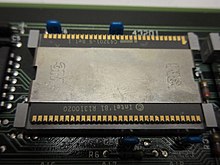
A graphical user interface, or GUI, is a form of user interface that allows users to interact with electronic devices through graphical icons and visual indicators such as secondary notation. In many applications, GUIs are used instead of text-based UIs, which are based on typed command labels or text navigation. GUIs were introduced in reaction to the perceived steep learning curve of command-line interfaces (CLIs), which require commands to be typed on a computer keyboard.

LilyPond is a computer program and file format for music engraving. One of LilyPond's major goals is to produce scores that are engraved with traditional layout rules, reflecting the era when scores were engraved by hand.

Sibelius is a scorewriter program developed and released by Sibelius Software. Beyond creating, editing and printing music scores, it can also play the music back using sampled or synthesised sounds. It produces printed scores, and can also publish them via the Internet for others to access. Less advanced versions of Sibelius at lower prices have been released, as have various add-ons for the software.
Finale is a discontinued proprietary music notation software developed and released by MakeMusic for Microsoft Windows and macOS from 1988 until the 27th of August 2024, when it was discontinued.
Steinberg Media Technologies GmbH is a German musical software and hardware company based in Hamburg. It develops software for writing, recording, arranging and editing music, most notably Cubase, Nuendo, and Dorico. It also designs audio and MIDI hardware interfaces, controllers, and iOS/Android music apps including Cubasis. Steinberg created several industry standard music technologies including the Virtual Studio Technology (VST) format for plug-ins and the ASIO protocol. Steinberg has been a wholly owned subsidiary of Yamaha since 2005.
A scorewriter, or music notation program is software for creating, editing and printing sheet music. A scorewriter is to music notation what a word processor is to text, in that they typically provide flexible editing and automatic layout, and produce high-quality printed results.

Music engraving is the art of drawing music notation at high quality for the purpose of mechanical reproduction. The term music copying is almost equivalent—though music engraving implies a higher degree of skill and quality, usually for publication. The name of the process originates in plate engraving, a widely used technique dating from the late sixteenth century. The term engraving is now used to refer to any high-quality method of drawing music notation, particularly on a computer or by hand.
capella is a musical notation program or scorewriter developed by the German company capella-software AG, running on Microsoft Windows or corresponding emulators in other operating systems, like Wine on Linux and others on Apple Macintosh. Capella requires to be activated after a trial period of 30 days. The publisher writes the name in lower case letters only. The program was initially created by Hartmut Ring, and is now maintained and developed by Bernd Jungmann.
LispWorks is computer software, a proprietary implementation and integrated development environment (IDE) for the programming language Common Lisp. LispWorks was developed by the UK software company Harlequin Ltd., and first published in 1989. Harlequin ultimately spun off its Lisp division as Xanalys Ltd., which took over management and rights to LispWorks. In January 2005, the Xanalys Lisp team formed LispWorks Ltd. to market, develop, and support the software.
Apple Dylan is the original implementation of the programming language Dylan. It was developed by Apple Computer from 1992 to 1995.
Igor Engraver is a scorewriter for the Macintosh and Windows operating systems, created by Swedish composer Peter Bengtson and published by the Swedish company NoteHeads. Bengtson stated on the Igor-Talk mailing list that he named Igor after the stock character in various horror movies, and to commemorate Russian composer Igor Stravinsky.

Overture is a music notation (scorewriter) program for Windows and Macintosh platforms, published and developed by Sonic Scores. While Overture is primarily a scorewriter program, it also allows editing the score's MIDI audio playback data in the manner of sequencer and digital audio workstation (DAW) software.
MusicEase is a WYSIWYG scorewriter created by Gary Rader and produced by MusicEase Software. It enables computers using Microsoft Windows and macOS to produce musical notation and listen to them in MIDI.
In computing, Philip's Music Writer or PMW, formerly known as Philip's Music Scribe or PMS, is a music scorewriter written by Philip Hazel. It was mentioned in the Center for Computer Assisted Research in the Humanities publication Computing in Musicology in 1993 and remains under active development as free software.

Dorico is scoring software for macOS, Windows and iPadOS. Along with Finale and Sibelius, it is one of the three leading professional-level music notation programs. Dorico is developed by Steinberg, a subsidiary of Yamaha, and its development team consists of most of the former core developers of a rival software, Sibelius.
Standard Music Font Layout, or SMuFL, is an open standard for music font mapping. The standard was originally developed by Daniel Spreadbury of Steinberg for its scorewriter software Dorico, but is now developed and maintained by the W3C Music Notation Community Group, along with the standard for MusicXML.






